
The Boeing C-40 Clipper is a military version of the Boeing 737 Next Generation used to transport cargo and passengers. It is used by the United States Navy, Air Force, and Marine Corps. The Navy C-40A variant is named "Clipper", whereas the USAF C-40B/C variants are officially unnamed.

Naval Air Station Glenview or NAS Glenview was an operational U.S. Naval Air Station from 1923 to 1995. Located in Glenview, Illinois, a suburb of Chicago, the air base primarily operated training aircraft as well as seaplanes on nearby Lake Michigan during World War II. Reconfigured as a Naval Air Reserve base following World War II, NAS Glenview supported Naval Air Reserve, Marine Air Reserve/4th Marine Aircraft Wing, and U.S. Army Reserve 244th Aviation Group as well as an active duty Coast Guard Air Station.

Naval Air Station Jacksonville is a large naval air station located approximately eight miles (13 km) south of the central business district of Jacksonville, Florida, United States.

Naval Base Ventura County (NBVC) is a United States Navy base in Ventura County, California. Formed by the merger of NAS Point Mugu and CBC Port Hueneme, NBVC is a diverse installation composed of three main locations — Point Mugu, Port Hueneme, and San Nicolas Island. The base serves as an all-in-one mobilization site, deep water port, railhead, and airfield. NBVC supports more than 100 tenant commands with a base population of more than 19,000 personnel, making it the largest employer in Ventura County.
The Naval Air Transport Service or NATS, was a branch of the United States Navy from 1941 to 1948. At its height during World War II, NATS's totaled four wings of 18 squadrons that operated 540 aircraft with 26,000 personnel assigned.

Naval Air Station Joint Reserve Base New Orleans is a base of the United States military located in Belle Chasse, unincorporated Plaquemines Parish, Louisiana, United States. NAS JRB New Orleans is home to a Navy Reserve strike fighter squadron and a fleet logistics support squadron, the 159th Fighter Wing of the Louisiana Air National Guard, Coast Guard Air Station New Orleans, a detachment of a Marine Corps Reserve light helicopter attack squadron, as well as other US Navy and US Army activities. The base has a 24/7 operating schedule to support both the 159 FW's NORAD air sovereignty/homeland defense requirements and for Coast Guard Air Station New Orleans search and rescue/maritime law enforcement/port security missions. It contains a military airport known as Alvin Callender Field which is located three nautical miles (6 km) south of the central business district of New Orleans. The base's predecessor, NAS New Orleans, occupied the current location of the University of New Orleans's principal campus until 1957.

Fleet Logistics Support Squadron 30 (VRC-30), also known as the "Providers", is a United States Navy Fleet Logistics Support squadron based at Naval Air Station North Island consisting of 5 detachments. VRC-30 is one of only two active, carrier-capable, Fleet Logistics Support squadrons, the other being VRC-40.
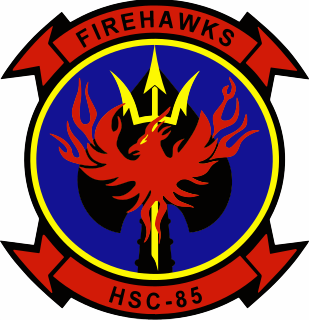
Helicopter Sea Combat Squadron EIGHT FIVE (HSC-85) is a United States Navy Reserve forces helicopter squadron (RESFORON) based out of Naval Air Station North Island in San Diego, California. The "FIREHAWKS" of HSC-85 are Reserve and Active Component Sailors who operate and maintain Sikorsky MH-60S Seahawk helicopters.
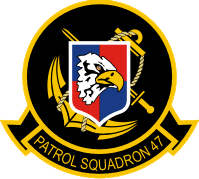
Patrol Squadron 47 (VP-47), also known as "The Golden Swordsmen", is a maritime patrol squadron of the United States Navy based at Naval Air Station Whidbey Island, Washington (USA), attached to Patrol and Reconnaissance Wing 10. The squadron currently flies the Boeing P-8A Poseidon.

Fleet Logistics Support Squadron 62 (VR-62), nicknamed the Nomads, is one of five U.S. Navy Reserve squadrons operating the Lockheed C-130T Hercules medium-lift cargo aircraft. Based at Naval Air Station Jacksonville, Florida, the squadron is manned by a combination of traditional part-time drilling Selected Reservists (SELRES) and a full-time active duty Navy Reserve cadre known as Training and Administration of the Reserve (TAR) personnel. The squadron is under the operational control of Commander, Fleet Logistics Support Wing(COMFLELOGSUPWING) at NAS JRB Fort Worth, Texas.

Fleet Logistics Support Squadron 64 (VR-64), nicknamed the Condors, is a logistics squadron of the U.S. Navy Reserve, based at Joint Base McGuire–Dix–Lakehurst. The squadron was established as Patrol Squadron 64 (VP-64) on 1 November 1970 and redesignated on 18 September 2004, after 34 years of service. It was based at NAS Willow Grove, Pennsylvania until it got transferred to Joint Base McGuire–Dix–Lakehurst in 2011. Units of the squadron made 26 major overseas deployments.
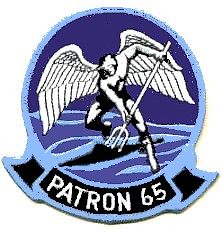
VP-65, nicknamed the Tridents, was a Patrol Squadron of the U.S. Navy Reserve. The squadron was established on 16 November 1970 at NAS Los Alamitos, California, and moved on 6 January 1971 to NAS Point Mugu. It was disestablished on 4 March 2006, after 35 years of service. Elements of the squadron made 22 major overseas deployments.
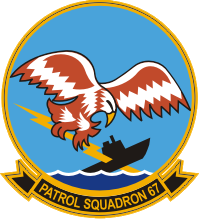
VP-67 was a Patrol Squadron of the U.S. Navy Reserve. The squadron was established on 1 November 1970 at NAS Memphis, Tennessee, where it was based for its entire life. It was disestablished on 30 September 1994, after 24 years of service. The squadron's nickname was the Golden Hawks, also unofficially called the Thunder Chickens. Elements of the squadron made 23 major overseas deployments.

VP-49 was a long-lived Patrol Squadron of the U.S. Navy, having held that designation for 45 years from 1948 to 1994. Its nickname was the Woodpeckers from 1973 to 1994. It was established as VP-19 on 1 February 1944, redesignated Patrol Bombing Squadron VPB-19 on 1 October 1944, redesignated VP-19 on 15 May 1946, redesignated Medium Patrol Squadron (Seaplane) VP-MS-9 on 15 November 1946, redesignated VP-49 on 1 September 1948 and disestablished 1 March 1994.
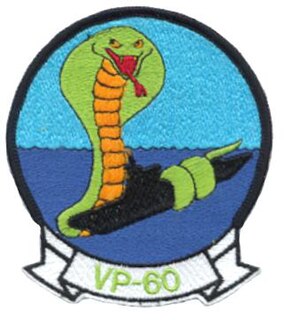
VP-60 was a Patrol Squadron of the U.S. Navy Reserve, based at NAS Glenview, Illinois. Its nickname was the Cobras. The squadron was established on 1 November 1970, and disestablished on 1 September 1994.

Patrol Squadron 30 (VP-30) is a maritime patrol squadron of the United States Navy, established on 30 June 1960. It is based at Naval Air Station Jacksonville, Florida.
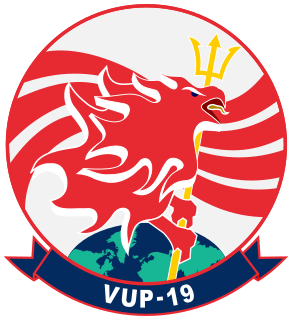
Unmanned Patrol Squadron 19 (VUP-19) is an unmanned patrol squadron of the United States Navy, nicknamed the "Big Red" and established on 1 October 2013.

Fleet Logistics Support Squadron 54 (VR-54), nicknamed "The Revelers", is a heavy-transport, logistics support squadron of the United States Navy. It is a Navy Unique Fleet Essential Aircraft (NUFEA) squadron based out of NAS/JRB New Orleans, Louisiana and is a sub-command of Commander, Fleet Logistics Support Wingand Commander, Naval Air Reserve Force. VR-54 is a Naval Reserve unit composed of both Full-time Support (FTS) and Selected Reserve (SELRES) Sailors. The squadron currently flies the Lockheed C-130T Hercules.



















